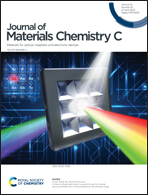Photocontrolled reversible modulation of lanthanide luminescence in mesoporous silica nanospheres by photochromic diarylethenes†
Abstract
Reversible modulation of the luminescence properties of Ln3+ ions has found many applications in the fields of biology, information and chemistry. However, it is still a challenge to efficiently remote control the luminescence of Ln3+ by light stimuli. In this paper, light-controlled luminescence ON–OFF switchable hybrid materials are successfully synthesized by loading Eu3+ complexes and photochromic diarylethenes (DAEs) into monodisperse mesoporous silica nanospheres (MSNs). Repeated cycles of UV and visible light irradiation switch the DAEs between closed-form and open-form isomers, where the closed-form DAEs (CF-DAEs) and Eu3+ complexes undergo Förster resonance energy transfer (FRET) due to the spectral overlap between the emission band of Eu3+ complexes and the absorbance band of CF-DAEs. Therefore, the luminescence of Eu3+ ions was repeatedly switched between ON and OFF states after successive UV and visible irradiation of the hybrid materials. This study opens the possibility of developing lanthanide-based photoswitches for optical anti-counterfeiting and data storage.



 Please wait while we load your content...
Please wait while we load your content...